
About UsThe Numismatic Bibliomania Society is a non-profit organization promoting numismatic literature. For more information please see our web site at coinbooks.org SubscriptionsThose wishing to become new E-Sylum subscribers (or wishing to Unsubscribe) can go to the following web page link MembershipThere is a membership application available on the web site Membership Application To join, print the application and return it with your check to the address printed on the application. Membership is only $15 to addresses in the U.S., $20 for First Class mail, and $25 elsewhere. For those without web access, write to: David M. Sundman, Secretary/TreasurerNumismatic Bibliomania
Society AsylumFor Asylum mailing address changes and other membership questions, contact David at this email address: dsundman@LittletonCoin.com SubmissionsTo submit items for publication in The E-Sylum, just Reply to this message, or write to the Editor at this address: whomren@coinlibrary.com
BUY THE BOOK BEFORE THE COINYou won't regret it! |
- WAYNE'S WORDS: THE E-SYLUM MARCH 14, 2010
- COMMENTS ON THE ASYLUM, OCTOBER-DECEMBER 2009
- BOOK REVIEW: CENTENNIAL HISTORY OF THE NEW YORK NUMISMATIC CLUB
- BOOK REVIEW: COLLECTING ANCIENT GREEK COINS BY PAUL RYNEARSON
- BOOK REVIEW: LE MONNAYAGE ET LES MONNAIES FAUTÉES 1780-2009
- DICK JOHNSON ON AMERICAN NUMISMATIC BIOGRAPHIES BY PETE SMITH
- MORE ON NICHOLAS VEEDER'S 1885 COMETALLISM PAMPHLET
- QUERY: SHIRJIEH PUBLISHERS
- MORE ON THE DIFFERENCE BETWEEN COPPER, BRONZE AND BRASS
- ON THE PURPLE HEART MEDAL AND CERTIFICATE
- MAN BUILDS MEMORIAL TO DICKIN-MEDAL WINNING PIGEONS
- NOTES FROM E-SYLUM READERS: MARCH 14, 2010
- MORE ON COIN CABINETS BY CRAIG MCDONALD
- MEDAL CABINET BY GEORGE BULLOCK C1816-1818
- MORE ON LEYDEN PAPER SIEGE COINS
- THE EMERGENCY MONEY COLLECTOR, VOL. 1 NO. 2
- HERBERT SHARPE'S 1959 REX KREWE MARDI GRAS DOUBLOONS
- MILLARD FILLMORE PRESIDENTIAL DOLLAR COIN LAUNCH CEREMONY
- 1868 THREE-CENT NICKEL FOUND IN CHANGE AT CHIC-FIL-A
- WAYNE'S NUMISMATIC DIARY: MARCH 9, 2010
- THE PICTUREIT RARE BOOK READER
- COLLECTING E-BOOKS?
- OLD BANK OF ENGLAND 20 POUND NOTE BEING DEMONETIZED
- MAN CAUGHT SUCKING COINS TO BEAT BREATHALYSER TEST
- THE "GELT SUIT"
- FEATURED WEB PAGE: THE SYDNEY COVE MEDALLION
WAYNE'S WORDS: THE E-SYLUM MARCH 14, 2010

Among our new subscribers this week are Patrick Ian Perez, Ken Brown, Gene Brandenburg and Michael Shutterly. Welcome aboard! We now have 1,326 subscribers.
This week we open with comments on the latest Asylum, three numismatic book reviews, and comments on American Numismatic Biographies and Veeder's 1885 pamphlet on Co-Metallism.
Other topics include coin and medal cabinets, Shirjieh Publishers, Purple Heart Certificates, and the Millard Fillmore dollar launch ceremony. To learn about 150-year-old coins in change at Chick-Fil-A, the "Gelt Suit", Portuguese Joe and determining coin authenticity by sense of smell, read on.
Wayne Homren
Numismatic Bibliomania Society
COMMENTS ON THE ASYLUM, OCTOBER-DECEMBER 2009
Jeff Reichenberger writes:
I wanted to mention how much I enjoyed the latest issue of The Asylum (vol. 27, No. 4, Oct.-Dec. '09), the entire contents of which was thoroughly engrossing. I particularly found interesting the contrast in the successful research approaches between the article by Len Augsburger and Joel Orosz, and the article by David Fanning and Eric Newman - one team spelunking through the city archive bowels of Philadelphia, the other clicking around on Google. Whatever works! Much thanks to David Yoon and those who put together a great journal.
BOOK REVIEW: CENTENNIAL HISTORY OF THE NEW YORK NUMISMATIC CLUB
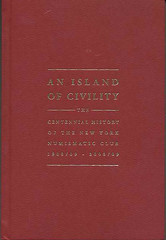 Over the last couple weeks I've read major portions of
An Island of Civility - The Centennial History of the New York Numismatic Club 1908/09 - 2008/09
by John Kleeberg and David T. Alexander. The 437-page book is limited to 150 copies (not 125, as previously reported here).
Over the last couple weeks I've read major portions of
An Island of Civility - The Centennial History of the New York Numismatic Club 1908/09 - 2008/09
by John Kleeberg and David T. Alexander. The 437-page book is limited to 150 copies (not 125, as previously reported here).
The book is arranged in four main chapters. The first is a chronological history beginning with the club's founding in 1908. The next chapter is a topical overview, focusing on key individual aspects of the club throughout its' long history. The third chapter is a catalogue of medals issued by the club and related organizations and individuals. The final chapter is comprised of biographical sketches of all the club's members from 1908 through 2009.
As I mentioned in the earlier announcement of the book's availability, the club's location in New York virtually assured its participation in numismatics on a national stage. Many key players in the club were also heavily involved with the American Numismatic Society, and included many of the top collectors and dealers of the era.
 Among those listed on the membership rolls are Edgar Adams, Harold Bareford, Fred Boyd, David Bullowa, John Clapp, Homer Downing, Tom Elder, Aaron Feldman, Albert Frey, Henry Grunthal, Julius Guttag, William Hesslein, Abe Kosoff, Lyman Low, Ted Newell, Sydney Noe, David Proskey, J. Sanford Saltus, D. W. Valentine, Howland Wood, and William H. Woodin. With a stellar membership like that, how could this book NOT be important?
Among those listed on the membership rolls are Edgar Adams, Harold Bareford, Fred Boyd, David Bullowa, John Clapp, Homer Downing, Tom Elder, Aaron Feldman, Albert Frey, Henry Grunthal, Julius Guttag, William Hesslein, Abe Kosoff, Lyman Low, Ted Newell, Sydney Noe, David Proskey, J. Sanford Saltus, D. W. Valentine, Howland Wood, and William H. Woodin. With a stellar membership like that, how could this book NOT be important?
The chronological chapter of the book begins, naturally, with the story of the club's founding. Turmoil at the American Numismatic Society and its move to a faraway uptown location left a void in the far more populated downtown. Together with the desire of the American Numismatic Association to have a rival branch in the ANS' hometown led to discussions of a new local organization separate from the venerable ANS. After a couple of organizing meetings the club held its first formal meeting at Keen's Chop House on December 11, 1908.
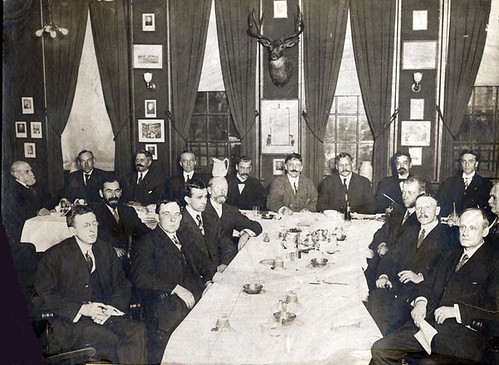
QUICK QUIZ: Who can name the numismatists in this
photo of the November 12, 1909 meeting?
Most of the early members were also very active in the ANA and the national numismatic scene. One such episode of national numismatic importance was the 1909 campaign for the presidency of the American Numismatic Association. NYNC President Frank Higgins (backed by Thomas Elder) ran against John Henderson (backed by Farran Zerbe). If you thought some of the recent elections were controversial, they were nothing compared to the knock-down drag-out name-calling, insult-throwing, back-stabbing, proxy-grabbing election of 1909.
Many numismatic bibliophiles are familiar with the election because of various items of campaign ephemera that remain today. Two of the rarest items are keys to deciphering the mysteries of the candidates' campaign platforms. I collect American numismatic ephemera, and I've never encountered either of these items "in the flesh".
One is a 13-page booklet mailed to several ANA members titled From the Campaign Committee of the New York Numismatic Club Re The American Numismatic Association Convention.
The other is described as follows on p15:
Publisher Zerbe's extraordinary 6 5/16 x 56 inch scroll inserted and mailed with the August issue of The Numismatist. The scroll-insert was nearly as long as Zerbe was tall, and it bore the flaming masthead The ANA Campaign and its Question, The Association Defiled and Defied.
Co-author David Alexander wrote a great article about the ephemera of the 1909 election in our print journal, The Asylum, in 1993. At that time no copy of the NYNC campaign booklet could be found. "Since then a copy of this elusive brochure surfaced in the NBS collection and with it a new reading of events". I was confused by the reference for the "NBS collection", but clarified this with David Alexander, who writes:
The 1910 election chapter was one of several I contributed, based on two articles for "The Asylum" that were written when Martin Gengerke was editor. The first article noted that the NYNC brochure issued for the election, referred to by Zerbe and others since, could not be found ANYWHERE.
The story went to press and up piped the late Frank Van Zandt, NBS officer and collector, who volunteered cheerfully that he had a copy of this legendary brochure! He sent it to me and it became a second article for NBS! Properly we should have cited Frank Van Zandt's collection, not NBS.
In the end, Higgins lost to Henderson in a landslide.
There is far more to the book than this 14-page dive into the platforms and tactics of the 1909 campaign, but this section alone is enough to make the book indispensible for the student of American numismatic history.
The authors write: "... even after a century, the NYNC's campaign booklet promoting Higgins makes us wonder whether the ANA took a wrong turn in 1909. How might the history of the national organization have been changed by the club's little-appreciated numismatic platform?"
The next section discusses the creation of the club's charter in 1909. Pictured is D. Macon Webster, an African-American lawyer who joined the club that year and drafted the charter. A later section discusses the club's long history of inclusion, highlighting prominent early African-American, Jewish and female members.
Chapter two begins with a discussion of the club's meeting places over the years. For its first five years the club met at Keen's Chop House. I had the pleasure of dining there myself in 1995. Despite economic ups and downs and changes in dining fashion, Keen's is still there. The club held its 100th anniversary meeting there in 2008.
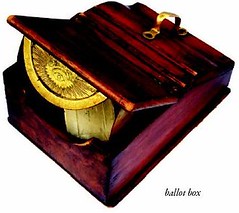 Other sections in the topical chapter of the book discuss membership, attendance, constitutional issues, and other topics. The club owns a formal ballot box, pictured on page 91.
Other sections in the topical chapter of the book discuss membership, attendance, constitutional issues, and other topics. The club owns a formal ballot box, pictured on page 91.
The club owns a ballot box with ivory balls to vote in favor of a prospective new member and black cubes to vote against (cubes, rather than balls, are used, so that members will blackball intentionally and not out of negligence).
There is also a discussion of young numismatists. From p103:
Another young numismatist attended a meeting on August 12, 1938. "The President called on Master Joe Lasser, from the Westchester Numismatic Club. Master Lasser stated that he collected everything, but was particularly interest in commemorative coins." ... This description of his collecting interests was still true over a half a century later (except one should substitute "Columbian" or "Dutch" for "Commemorative").
Lasser donated a large collection of coins of the American colonies to Colonial Williamsburg in 2005, and he is an E-Sylum reader.
The club embarked on several publishing projects, but like most committee endeavors, not all came to fruition. The club published a Yearbook for 1918 - 1919 - 1920 - 1921 but never published another. A project to catalog New York tokens was published serially in the Coin Collector's Journal. Member Daniel Valentine published a book on Fractional Currency under the auspices of the club, and in 1961 a 56-page booklet on the club's early history was published.
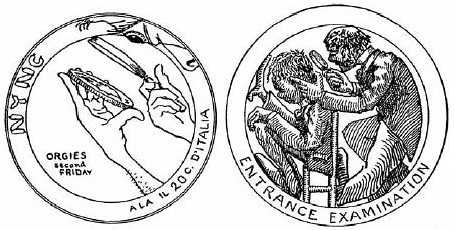
Howland Wood's Satirical Club Seal Designs (p40)
Chapter three covers the medals of the NYNC and related clubs and spans pages 147-288. Every medal is pictured, most in color. For medal collectors, this is the heart of the book. The series of Presidents' medals is avidly collected, and this catalog will be indispensible for collectors of the series.

Reverse of the 1910 Frank C. Higgins medal
The book doesn't end there. Chapter Four spans pages 289-402 and includes capsule biographies of every club member from 2908-2009. The entire book is a great read, and there is no shortage of interesting tidbits of numismatic trivia here. Which famed numismatist...
- ... was crippled by a shotgun blast to the leg at the age of twelve?
- ... studied the coinage of the George Junior Republic?
- ... was tutored in collecting coins by David Proskey?
- ... died in a house fire with his wife and two servants?
- ... threw Bob Dylan out of a Bleecker Street cafe "because he was singing, playing his guitar and annoying a lot of people?"
- ... had a felony conviction for counterfeiting?
- ... would decide questions of coin authenticity by sense of smell?
- ... was a coin dealer whose mysterious disappearance vexed many whom he owed money?
- ... was said to catalogue "with a tray of Roman coins on one side and a bottle of Scotch on the other"?
- ... owned the Texas School Book Depository building and collected other Kennedy memorabilia by rooting through the trash of Jacqueline Kennedy Onassis?
- ... wrote a history of the Bureau of Engraving and Printing?
- ... got permission from the Nazi Gestapo to run coin auctions in the 1930s?
- ... had his suicide hushed up as an accidental death?
- ... wrote numismatic articles under the pseudonym "Portuguese Joe"?
If you already own the book, no fair peeking. Hint: these are in alphabetical order by last name. I'll publish your answers, but won't necessarily reveal the full list - you'll have to buy the book for that.
The remainder of the book consists of appendices covering the authors' sources and references, club meeting places, membership and attendance statistics, special meetings, honorary and corresponding members, publications, medal winners, officers, speakers and their topics, and keys to group photographs.
This book is a must for the library of the serious American numismatist. If the price of $125 plus $10 shipping seems high, remember that this 400+ page hardbound book is at least three books in one, each of significant merit. And with a print run of only 150 it will surely go out of print someday soon, at which time I doubt a copy would be obtainable for less than twice that price.
NBS doesn't give "Book of the Year" awards - that's the purview of the Numismatic Literary Guild (NLG). But I bet An Island of Civility will be in the running. Congratulations to authors Kleeberg and Alexander, and the entire New York Numismatic Club for a job well done. Thanks also to John Kleeberg and Constantin Marinescu for forwarding images for use in this review.
To read the earlier E-Sylum article, see: NEW YORK NUMISMATIC CLUB CENTENNIAL HISTORY PUBLISHED (www.coinbooks.org/esylum_v13n04a06.html)
For ordering information, see: ORDERING THE NEW YORK NUMISMATIC CLUB CENTENNIAL HISTORY (www.coinbooks.org/esylum_v13n05a07.html)
BOOK REVIEW: COLLECTING ANCIENT GREEK COINS BY PAUL RYNEARSON
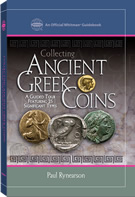 I would like to comment on Paul Rynearson's Collecting Ancient Greek Coins, which you have published.
Bottom line: if a collector were to purchase just one book on the subject of ancient Greek coins, this is that book. I purchased it last year and I have enjoyed it on each readingâ three so far.
I would like to comment on Paul Rynearson's Collecting Ancient Greek Coins, which you have published.
Bottom line: if a collector were to purchase just one book on the subject of ancient Greek coins, this is that book. I purchased it last year and I have enjoyed it on each readingâ three so far.
There are four general types of books in this area available to collectors:
(1) basic price catalogs, the most notable example probably being Sear's two-volume Greek Coins and Their Values;
(2) âpretty picture' books, such as Berk's The Hundred Greatest Ancient Coins (which you publish);
(3) scholarly studies in particular series, such as Lorber's Amphipolis - Civic Coinage in Silver and Gold; and
(4) collection catalogs, such as The Arthur S. Dewing Collection of Greek Coins (edited by Mildenberg and Hurter), and of course the entire Catalogue of the Greek Coins in the British Museum. Dr. Rynearson's book does not replace any of them (and does not purport to), but it provides enough of the elements of each of them to be entirely satisfying by itself.
The book provides a wealth of information that is almost critically necessary for the beginning or intermediate collector, and yet much of it is not available in any single source â except in this book. And even the most advanced collectorâ who may already knows all of the âfacts' in the bookâ can appreciate the book for its grace, style, and aesthetic commentary.
One masterstroke (among many) is in Dr. Rynearson's suggestions for putting together a much-better-than-basic collection of Greek coins: he identifies and describes a very well-thought out program whereby a collectorâ who perhaps admires but does not possess the wealth of Kroisos â could, over time, assemble a wonderful collection that would present enjoyable challenges, while fully satisfying his or her interests in the aesthetics, culture and history of the time.
The production values of the book are satisfying as well. The illustrations are superb, and they do ample justice to the quality of the coins they depict.
I do have two nits to pick, and I suspect that neither of these is the fault of Dr. Rynearson.
The Preface includes a picture of a âstater' (I prefer ânomos') of Metapontumâ the archaic version of which, appearing in chapter 3 of Part II, is one of my favorite coins, brilliant in its stark simplicityâ and the accompanying description notes that the coin depicts âan ear of corn.' I suspect that one of your editors found that reference in a British catalogue, and while it is a common description, alas, it is one that could be somewhat confusing to an American reader, for whom âear of coin' means something that no one in âMetapontum' would ever have seen: for us in the US, âcorn' means maize, a specific grain cultivated in the New World and not introduced into Europe until more than 18 centuries after this coin was minted, whereas in Britain, âcorn' means the edible seed of whatever grain happens to be locally available (wheat in England, oats in Scotland, and, as it happens, barley in âMetapontum').
When the next edition of the book comes out, I would respectfully request that you revise the Preface to refer to the grain as an âear of grain' (as Dr. Rynearson does, on p. 119) or an âear of barley' or, if you absolutely insist on using the word âcorn,' then call it a âbarleycorn,' but please, not âear of corn.'
My other nit, also related to something in the Preface, is that you used the Latin form of the names of the coin-issuing sites: instead of âMetapontum' and âTarentum,' you should be using the (more accurate) Greek âMetapontion' and âTaras' (as Dr. Rynearson does, consistently, elsewhere in the book).
The only other request I would make is that you commission Dr. Rynearson to prepare a companion volume, Collecting Ancient Roman Coins. The field of Roman coins has the same need for such a book as the field of Greek coins hadâ until Dr. Rynearson filled it so well.
Thank you for making this wonderful book available to the public.
Dennis Tucker adds:
Thank you so much for sharing your thoughts on Paul Rynearson's Collecting Ancient Greek Coins! It's always nice to hear from appreciative readers.
The preface was Whitman's, not Dr. Rynearson's, and it drew from Klawans, which explains the inconsistencies with Rynearson's main text. Excellent observations, and we'll make the changes you've recommended in the 2nd edition.
BOOK REVIEW: LE MONNAYAGE ET LES MONNAIES FAUTÉES 1780-2009
CHORT, Jean-Claude. Le monnayage et les monnaies fautées 1780-2009, 1st ed. Monaco: Éditions Victor Gadoury, 2009. [French language, fully illustrated in colour, 15 x 21 cm, 432 pages, hardbound (ISBN 2-906602-37-X), â¬39]
 Chort's Le monnayage et les monnaies fautées 1780-2009 (The coining process and error coins 1780-2009) is quite simply an outstanding book!
Chort's Le monnayage et les monnaies fautées 1780-2009 (The coining process and error coins 1780-2009) is quite simply an outstanding book!
Jean-Claude Chort's 35-year passion for error coins is evident is this well-organized and well-documented book. While focusing on French coinage from 1780 to 2009, the information contained in this unique document can easily be applied to all error coins, regardless of their origin.
Chort begins by explaining the coining process from antiquity to today, since one must really understand this process to determine when and what went wrong to create the error coin. Then he proceeds â and this is really the meat, the most important part on this book â into the classification aspects. Indeed, Chort has organized the various errors into four main categories (die/collar; blank/planchet; mounting, adjustment, and feeding; and strike) that are in turn divided into subcategories and sub subcategories. For example:
- 1 - die/collar
-
2 - blank/planchet
- 1 - laminating error
-
2 - blanking error
- 1 - crescent-shaped
- 2 - ellipsoidal
- 3 - sheet edge
- 4 - unpierced Lindauer and Ãtat français
- 5 - off-centre hole
- 6 - double hole
- 7 - doubled-cut ring
- 8 - off-centre ring
- 9 - cut ring
- 3 - assembly error
- 4 - plating error
- 5 - faulty copper plating
- 6 - metal or alloy problem
- 3 - mounting, adjustment, and feeding
- 4 - strike
So, a coin described as an error code "223" is a coin struck on a blank that came from the edge of a sheet of metal. But Chort was not satisfied with just organizing the various types of error, he explains each sub subcategory using diagrams (that show, for example, how the planchet would have been positioned between the dies) and photos (with enlargements) of actual error pieces.

Following this important chapter he cautions the readers about, and helps them identify, tampered pieces ("false errors"). Finally, he lists various error French pieces and gives an approximate value for each type of error.
This book is an absolute MUST for anyone interested in error pieces or in the coining process. It is highly recommended.
For more information or to order, please visit the Ãditions Victor Gadoury's website at www.gadoury.com .
THE BOOK BAZARRE
DICK JOHNSON ON AMERICAN NUMISMATIC BIOGRAPHIES BY PETE SMITH
Reacting to the announcement in last week's E-Sylum I took a test drive in Pete Smith's new databank now on the Internet. I became addicted. I couldn't stop looking up famous and not-so-famous personalities in the numismatic field.
Admittedly I had Pete's 1992 printed version on my desk the week before and had not reshelved it yet. Thus I had a chance to compare the two. There were 1,400 named entries in 1992. Now on the Internet the number is over 1,700. I had guessed there are on average between six and seven entries per page where I would have guessed 1,800. The printed version had 252 pages. There are 270 pages on the Internet (all bear page number "1" but Pete tells me this will be corrected in the next update).
Who's in? Who's out? The printed version had ten pages of introductory matter that is not on the Internet. That is where Pete spelled out his criteria for inclusion. He tells me he is still holding to these standards: U.S. Treasury and Mint officials. Designers, engravers and sculptors of U.S. coins and medals struck by the Mint. People who have appeared on U.S. coins and Mint medals. These are all included.
Then there are the authors. Bless them. Authors never receive enough credit in print. Most worthwhile numismatic books are a labor of love and never earn their authors a sufficient return for the hours spent researching and writing. Pete has made extreme efforts to learn the facts about authors of every major book in the numismatic field, all the way back to Montroville Wilson Dickeson "Author (b 1813 d.4/4/1882)."
Next are the officers in numismatic organizations. Presidents, yes. Vice presidents, no (unless they accomplished something else).
Collectors are in if they formed a major collection, or it has sold in a major auction. If you are a collector and hiding your collection in a safe deposit box and not telling anyone, how is Pete to know about you?
You won't make Pete's list if you have written only a single article in the field. Likewise collectors or authors of foreign numismatics are not included.
Major dealers are in. Vest-pocket dealers need not apply. You really have to have done something -- made a significant accomplishment in the numismatic field -- to be listed in American Numismatic Biographies.
Already it is being called "ANB." It's ANB on NBS. The Numismatic Bibliomania Society is sponsoring this wonderful resource on their website.
E-mails did not exist prior to 1992 for Pete's first version. He had to mail out questionnaires or interview people in person (at coin shows or by phone). Now he gathers a great deal of facts on people by e-mail.
He maintains a suspense file, what he calls "place holder," for people whose listing and biographical data he has decided to include but is still gathering facts. [Wikipedia calls this a "sandbox."] This activity goes on constantly.
Just since last week's announcement Pete has added two new entries. Additions, and, of course, corrections, will go on forever. As for corrections "Herman" MacNeil's name in the 1992 version now bears the correct "Hermon" and James Fraser's middle name is now "Earle."
But he is looking for a lot of living numismatists to come forward with their personal bio facts.
For numismatic writers Pete has provided a fantastic useful resource. It is ideal for fact checking and recovering forgotten facts. Look it up. It is easy to click on and enter a name or keyword.
You won't be able to copy or print any text. But you can read a great deal of very useful information in the numismatic field.
Pete is to be commended for providing this wonderful resource. I, for one, will be using it often.
To read the earlier E-Sylum article, see: SMITH'S AMERICAN NUMISMATIC BIOGRAPHIES AVAILABLE ON NBS WEB SITE (www.coinbooks.org/esylum_v13n10a02.html)
To view Pete Smith's American Numismatic Biographies, see: www.coinbooks.org/resources/anb_2010.pdf
MORE ON NICHOLAS VEEDER'S 1885 COMETALLISM PAMPHLET
Stephen Searle writes:
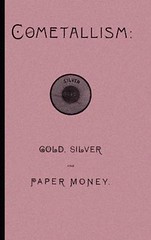 Also, by the way, the booklet has been reprinted in a limited edition of 85 numbered copies! I was surprised to see this for sale (and equally surprised at the $195 price.)
Also, by the way, the booklet has been reprinted in a limited edition of 85 numbered copies! I was surprised to see this for sale (and equally surprised at the $195 price.)
For more information on the reprint, see: Cometallism: A Plan for Combining Gold and Silver in Coinage, for Uniting and Blending Their Values in Paper Money, and for Establishing a Composite Single Standard Dollar of Account (www.abebooks.com/servlet/BookDetailsPL?bi=965119985)
To read the earlier E-Sylum article, see: VEEDER'S 1885 CO-METALLIC MONEY PROPOSAL (www.coinbooks.org/esylum_v13n10a19.html)
QUERY: SHIRJIEH PUBLISHERS
Patrick Ian Perez writes:
I am a numismatic researcher/writer and dealer specializing in paper money. I have enjoyed the recent articles on copyrights and also the article in this month's Numismatist, because I have a problem of my own. I have done a lot of searching around already, but I would kindly ask if anyone knows of any resources to find about numismatic publishing companies from the past and how to find out who owns the copyrights (if anyone) for a given book.
The company I am trying to find is Shirjieh Publishers. They were active in the late 60's and 70's I believe. I would truly appreciate any information that can be provided.
Shirjieh was incorporated in Menlo Park, California. The specific book I am looking for information on is Chinese Banknotes by Ward Smith and Brian Matravers, published in 1970. I do not know of any other books published under the Shirjieh name, although there is another company by the name of Chenby Publishers also from Menlo Park that published a book called Coins of the Philippines by Aldo Basso in 1968. Could the two companies (Shirjieh & Chenby) be related? Thanks for any help your readers can provide.
MORE ON THE DIFFERENCE BETWEEN COPPER, BRONZE AND BRASS
The difference to me, as a chemist in my former life, is that bronze is mainly copper plus tin (not zinc) in various proportions, and brass is mainly a copper-zinc alloy. For example, cartridge case (brass) cents contained zinc, and thereafter both tin and zinc (like the early bronze small cents).
How to tell the difference just by looking? Bronze might appear a bit grainy and dull, without the brighter and shinier appearance of most things brass. Think of yellow brass hardware. Bronze is less stable to oxidation in general and darkens faster than brass. Think statues.
Of course, all comparisons depend on the percentage composition of the components. There is really no clear-cut delineation. Once you go to mainly tin, with copper and other elements, you get pewter. And once you go to centuries-long aged medals, there's likely no visible difference between most bronze and brass. So what I might disagree with is that:
"I checked my entry on Bronze in my Encyclopedia of Coin and Medal Technology and found 26 names of bronze alloys that have been used as the composition for coins and medals. It is all a matter of the amount of zinc (generally) alloyed with copper."
It may well be that any bimetallic alloy of copper with either tin or zinc might is called bronze in some circles. But I'm pretty sure that the term 'brass' should connote zinc, rather than tin, as the major component with copper (but usually along with some tin).
I suspect you will hear from several people about the comment in the last The E-Sylum about Copper vs Bronze vs Brass, in which Dick Johnson wrote that bronze is copper mixed with zinc. Though these metals do cause numismatists a lot of trouble, he is dead wrong about bronze and zinc. Copper is an element, a basic metal which does exist in nature as a metal. In its natural metallic state or as a pure refined metal, it is -- well, copper colored ---- a lighter or darker brown depending on the amount of surface oxidation.
Bronze is an ancient alloy of copper and another metallic element, tin --- not zinc. The Bronze Age was named for the widespread use of this alloy in ancient times, both in Europe and Asia. Coins and objects made bronze, when new, are reddish brown or chocolate brown in color. In time they patinate with a layer of usually green oxidation (though the patination can be blue or red or other colors depending on burial conditions).
Brass is an alloy of copper and the element zinc, and is usually yellow in color, though it will darken to brown in time. Brass is a relatively modern "invention." Coins and other objects made of brass did not exist before the 1400's AD. There are some who claim that some ancient brass objects are genuine, but this is not true. So lets be clear -- ancient coins in brass are not genuine. The same applies to other objects which may look old and may have a green patina, but they can not be genuine if they contain zinc.
The reason for this is the peculiar nature of zinc. It does not exist in metallic form in nature, and generally can not even be an accidental alloy in an ancient object. Zinc has a very low melting point, and when heated, it passes directly to a gas and evaporates. So even if zinc ore was thrown into an ancient melting pot, the metal would simply evaporate and disappear.
The only way to produce metallic zinc (which can then be mixed with copper) is to heat it in a covered crucible. The zinc gas flows out a pipe in the top, is lead away and cooled, and solidifies as pure metallic zinc. This process was discovered in India in the early 1400's and spread from there to China. The metal was introduced to Europe from China -- Europeans had no idea what it was or how it was made. In the 1400's the Chinese changed their coinage from bronze to brass because zinc is much cheaper and more readily available than tin.
Trace amounts of zinc do turn up in ancient objects, but only in very small amounts (less than 1 percent) due to some fluke in production. So the presence of zinc (more than 1 percent) in a purported ancient object, is evidence that it is not genuine. The object must have been made after 1400 by mixing some brass with copper or bronze. The same is true with aluminum, which though extremely common in the earth's crust, does not exist in nature as a metal. The first metallic aluminum was not produced until the early 1800's and as late as 1850 there was not a kilogram of aluminum on the entire planet.
Some supposed ancient coins have turned up in recent years with traces of aluminum -- say, 1 or 2 percent. These too, despite their ancient look and wonderful fake patina, can not be genuine because of the presence of aluminum. Whoever made these fakes, must have thrown some aluminum-bronze metal into the melting pot when mixing the metal for the coins. Unfortunately there is no way to spot the presence of aluminum from appearance when in such small amounts.
And yes, nickel silver and German silver are different names for copper-nickel. There is no silver in the mix, normally, and the amount of copper is normally higher than the amount of nickel (which is more valuable). Usually it's around 75 percent copper and 25 percent nickel, but the ratio varies depending on the alloy desired. Other metals might also be present.
This brings us to the other metal problem facing numismatists -- "white metal." In the 19th century many tokens and medals were made in imitation of silver, using various combinations of cheaper metals, especially lead, zinc, nickel and tin. After 1890 aluminum was also used for this purpose. These various alloys are often difficult to identify, particularly if the medals or tokens can not be handled (in cases, for example, or slabbed), so in the 19th century numismatists began using the term "white metal" for any white colored alloy other than silver.
One medal or pattern coin might be described in one place as copper-nickel, in another as tin, in another as pewter, in another as aluminum, and in another as white metal. Do all of these varieties exist or have some been confused with others? The problem continues because new descriptions in catalogs or auctions are often just as wrong as the old descriptions.
What we need is a small, inexpensive device which can identify several different metals using a non-destructive method. The jewelry industry has two or three different kinds of hand-held devices for determining whether a diamond is real. We need something like that.
Among stamp collectors there are several different color charts available, though those made in England and those made in the USA sometimes have different names for the same color shade. But I have never seen such a chart for metal. Companies which supply non-ferrous sheet metal might have a website with images, but I'm not sure we could rely on their color control on the website. Moreover, color alone probably wouldn't be enough to identify metals.
I collect aluminum type coins, pre-1890 aluminum medals, and medals relating to the aluminum industry. I can tell you that it is often necessary to check the weight of a medal to know whether it is aluminum or something else. Aluminum can sometimes look very much like silver. Tin-zinc compounds also tend to be light weight, but the color is different than aluminum. Aluminum coins or medals with a proof or proof-like surface are easy to distinguish from tin or pewter or other white metal compounds with a proof-like surface. But once they start toning, they can be very confusing.
As I said, what we need is some sort of affordable device which performs a test (chemical or using radiation) to identify metals present in a coin. Such a device could also be useful to quickly spot counterfeits. If the supposed ancient coin contains zinc or aluminum, then we know it isn't genuine. Testing for trace elements could also provide a clue to where the metal came from.
For example, a copper mine in one area might produce metal with small amounts of iridium, while a mine in another place might produce metal with trace amounts of tungsten (but not iridium). Copper coins produced in both areas with the same design could be separated into those containing iridium and those containing tungsten, and those containing neither. Knowing where the metal came from might allow us to attribute the coins to particular mints or particular political entities.
Celtic coins, for instance, were made in an area stretching from Ireland to the Black Sea. Identifying the metal source might narrow down where such coins were made. The same is true in China for Pan Liang and Wu Chu coins, which were made across most of the country. Identifying the source of the metal might allow us to determine where specific varieties were made and perhaps even provide a rough date in some cases. Wu Chu coins, for example, were made for 700 years (114 BC to about 600 AD). If we find that the metal in one variety comes from a place which wasn't settled until around 400 AD, then we can infer that those coins were not made until 400 AD or later.
Of course a device which could date copper or bronze objects would be invaluable not only in the numismatic field but also in the antiquities field. There was a fellow back in the 1980's who was working on a C14 dating method using the tiny amounts of air trapped inside cast bronze. The object would have to be destroyed, of course, to get at the air. As far as I know, he never was successful with the process. Perhaps we should focus on the tin. Does tin have radioactive forms which break down and can be measured? Are there any physicists out there reading this?
John W. Adams adds:
I would recommend that the curious set themselves up to do specific gravity testing. The available equipment has improved over the years, so those who may have dismissed it in the past should give it a second look.
There is such a big difference between the specific gravity of copper (8.96) and zinc (7.13) and tin (7.31) that mixed compositions are relatively easy to quantify. For a whole bunch of technical reasons, which I will discuss in my new book on the Vernon medals, color may reveal the metal SOME of the time but is not a reliable guide overall.
To read the earlier E-Sylum article, see: WHAT'S COPPER? WHAT'S BRONZE? WHAT'S BRASS? WHAT'S THE DIFFERENCE? (www.coinbooks.org/esylum_v13n10a11.html)
THE BOOK BAZARRE
ON THE PURPLE HEART MEDAL AND CERTIFICATE
Fred Schwan writes:
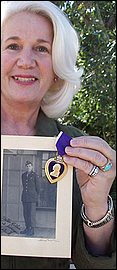 I would like to comment about on the Purple Heart story. While everyone recognizes the medal, in many ways, it is the certificate that is more important. Certainly, the certificates are more rare (much so) than the medals. The medals are just about indestructible so they will survive fires, flood, and even just poor handling over the decades. The certificate on the other hand is made of paper and fragile.
I would like to comment about on the Purple Heart story. While everyone recognizes the medal, in many ways, it is the certificate that is more important. Certainly, the certificates are more rare (much so) than the medals. The medals are just about indestructible so they will survive fires, flood, and even just poor handling over the decades. The certificate on the other hand is made of paper and fragile.
Additionally, the certificate has the full identity of the recipient of the award and details of the act in question. During World War II, expedient certificates were sometimes issued because the official and fancy certificates printed by the Bureau of Engraving and Printing were not available. Sometimes the person later received the more elaborate certificate, other times not. As BEP products, it is my opinion that the certificates themselves are numismatic items.
To read the earlier E-Sylum article, see: RESEARCHERS REUNITE PURPLE HEART CERTIFICATE WITH MEDAL (www.coinbooks.org/esylum_v13n10a21.html)
MAN BUILDS MEMORIAL TO DICKIN-MEDAL WINNING PIGEONS
 A PIGEON fancier is sculpting a memorial for the pigeons that acted as messengers during the war.
A PIGEON fancier is sculpting a memorial for the pigeons that acted as messengers during the war.
Neville Walbridge, 71, of Portland, will be creating a headstone that will list the names of the 32 pigeons that received the Dickin Medal - the animal equivalent of the Victoria Cross - for their work in the Second World War.
Mr Walbridge, who worked in the masonry and sculpture trade for most of his life, said the headstone should be finished by the summer and he hopes it will then be placed in Bletchley Park, the National Codes Centre, near Milton Keynes.
The site race controller for the Royal Pigeon Race Association (RPRA) said he became interested in pigeons when he found one holding a secret message in his back garden in 1942.
He said: "I was about four years old when I noticed a pigeon walking about.
"He looked tired so I put him in the chicken pen and took care of him.
"My father noticed he had a cylinder on his leg, which is where the messages were kept, and he took him down to Portland dockyard where the commanding officer of the Navy took him away.
"I was upset at the time but when the war was over he brought me six pigeons."
Mr Walbridge added: "If we want to send or receive secret messages there's only one way of doing it and that's through a racing pigeon.
"Every other method that is electronic can be tracked.
"The pigeons saved hundreds of people's lives."
Kelsey Griffin, director of museum operations at Bletchley Park, said: "A memorial to them is incredibly appreciated."
To read the complete article, see:
Portland man creates memorial to heroic pigeons
(www.dorsetecho.co.uk/news/localnews/5044803.
Portland_man_creates_memorial_to_heroic_pigeons/)
NOTES FROM E-SYLUM READERS: MARCH 14, 2010
Regarding the comments on the coming of polymer banknotes to Canada, Joe Boling writes:
I can assure you that polymer banknotes can be creased and folded - and once a tear starts, it keeps right on going. I have in hand some current Vietnamese polymer notes that are truly tatty - the worst condition polymer pieces I have ever seen - bordering on illegible. Well-circulated polymer can look just as bad as well-circulated paper.

Regarding the discussion on Italian coin denominations begun by Bruce Smith and continued by Bob Leonard, Serge Pelletier writes:
L'abbé Migne in his Dictionnaire de numismatique et de sigillograhpie religieuses (Paris, 1852), column 836 states: "JULES ou PAULES (PAOLI) monnaie d'argent qui se fabrique et a cours à Rome où elle vaux 10 baïoques" (Julis or paoli silver coin minted in Rome that circulates for 10 baiocchi )
To read the earlier E-Sylum article, see: MORE ON CURIOUS CURRENCY BY BOB LEONARD (www.coinbooks.org/esylum_v13n10a06.html)
MORE ON COIN CABINETS BY CRAIG MCDONALD
Regarding last week's pictures of his new coin cabinet, Ray Williams writes:
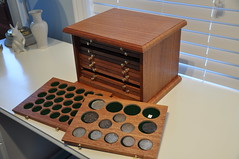 The pictures came out nice in The E-Sylum. I actually had several emails about the cabinets. I should have given you the website for anyone interested in Craig McDonald's coin cabinets... www.CabinetsByCraig.net, or you can email him directly at CabinetsByCraig@aol.com
The pictures came out nice in The E-Sylum. I actually had several emails about the cabinets. I should have given you the website for anyone interested in Craig McDonald's coin cabinets... www.CabinetsByCraig.net, or you can email him directly at CabinetsByCraig@aol.com
However, John W. Adams cautions:
Storage in wood can be death to the coin - there can be more bad chemicals in wood than in PVC flips. The warning about wood breaks my heart. I can't tell you how often I fantasized about having Bushnell's or Wilson's or Clapp's coin cabinet in my living room.
Ray's not so sure. He writes:
The old-time collections seemed to have been stored in Mahogony cabinets without any ill effect. I'd be interested to see what some chemists might have to say about it, if there are any subscribing to The E-Sylum.
To read the earlier E-Sylum article, see: RAY WILLIAMS' NEW COIN CABINET (www.coinbooks.org/esylum_v13n10a09.html)
MEDAL CABINET BY GEORGE BULLOCK C1816-1818
" Philadelphia antiques dealer Anthony Stuempfig (aapstuempfig@gmail.com) found the MCA website while searching for information on the CC Wright Erie Canal Medal to add to a website he publishes on early New York furniture. That led to an e-mail discussion of an extraordinary medal cabinet that he has available for sale. We now know that wood is not an ideal storage medium for medals due to the natural acidity, but this cabinet is an exceptionally beautiful object in its own right and a window onto the collecting habits of a very affluent - perhaps royal - medal collector of the early 19th century. "
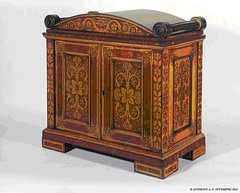
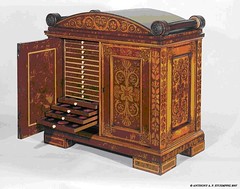
MORE ON LEYDEN PAPER SIEGE COINS
In our February 28th issue Joe Boling wondered:
Did John Sandrock really mean it when he said "There are eight known specimens..." of Leyden card siege money? Is it that rare? Or did he mean eight known types?
Charles Opitz writes:
I do not think there are only eight known as I have two in my own collection. I have attached a picture of the two along with a silver coin from the same die. This shows coin dies were used to make the paper coins. Excuse the center coin being turned slightly.
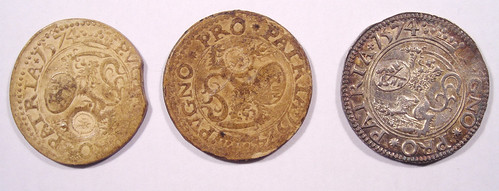
To read the earlier E-Sylum article, see: QUERY: TERM FOR PAPER PRESSED INTO COIN FORM SOUGHT (www.coinbooks.org/esylum_v13n08a14.html)
THE EMERGENCY MONEY COLLECTOR, VOL. 1 NO. 2
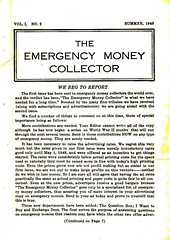 Arlie Slabaugh, Editor, reports that the first issue was a great success. Now he needs contributions from readers to keep the ball rolling. Also, he finds it necessary to raise advertising rates to cover the high cost of printing. Advertising rates are now $1.25 per inch or 3 cents per word. A quarter page ad is $3.50, a half page is $6.50 and a whole page is $12.00.
Arlie announces he is moving from the West Virginia School for the Deaf to Oakland, Maryland.
Arlie Slabaugh, Editor, reports that the first issue was a great success. Now he needs contributions from readers to keep the ball rolling. Also, he finds it necessary to raise advertising rates to cover the high cost of printing. Advertising rates are now $1.25 per inch or 3 cents per word. A quarter page ad is $3.50, a half page is $6.50 and a whole page is $12.00.
Arlie announces he is moving from the West Virginia School for the Deaf to Oakland, Maryland.
There is a new feature called "The Question Box" (What a novel idea). The first question is: What is the highest denomination of inflation paper money ever issued? The answer is 100,000,000,000,000,000,000 Pengos issued by Hungary in June 1946. If you have any questions for this feature, send them in!
There is an article on "Unusual Notgeld Issues Of Germany (1921-23)". There are two interesting features of this article. First, the listed issues (14 with various denominations) were all printed on silk or linen. Second, the article was translated from German by Arlie, himself.
The featured article of this issue is the start of a "Catalog of World War II Monies". These are all emergency issues. This article concentrates on National Government Issues. Just think, this article of 3 pages might be the first effort to catalog WWII emergency issues. The ancestor of SB and its' 864 pages Arlie wants to expand this and asks readers to submit input. Future articles will cover private, occupation, and military issues.
Arlie is very aware that there many unknowns yet to be discovered. What is very interesting about this list is that they are mostly coins - about 90%. They are national governments and French colonies. There are two governments listed that are not in SB (by my inspection). These are coins of Bulgaria and Egypt. It is not particularly confusing, but Arlie uses several older terms for countries, e.g., Siam for Thailand.
Advertised for sale is a set of Japanese Invasion Money (JIM) prepared for the invasion of the United States, Hawaii, and Alaska. All notes uncirculated. Nine pieces. No price listed. The seller, Norman Shultz of Salt Lake City, caveats the purpose by saying that this is the opinion of the Numismatic Scrapbook Magazine. Of course, we know that this JIM was used in the occupation of Malaya where the language was English and the money denominated in dollars and cents.
To read the previous E-Sylum article, see: THE EMERGENCY MONEY COLLECTOR, VOL. 1 NO. 1 (www.coinbooks.org/esylum_v13n10a07.html)
HERBERT SHARPE'S 1959 REX KREWE MARDI GRAS DOUBLOONS
In December 1959, Sharpe designed the Mardi Gras doubloon. The main qualm was the safety issue of throwing metal objects into the masses. Sharp informed the Rex krewe that he had designed some attractive doubloons that could be coined in aluminum and produced inexpensively in quantities and were safe. So what better way for Sharpe to prove that his new, light, aluminum prototypes were safe than by throwing them? And he did just that when he walked into the Rex office.
Astonished but not injured, they picked up the proofs and studied them for several minutes and said "Is this it?" That started the conversation that ended in an order of 80,000 to be minted. Though he was still very uncertain of the doubloon's success, They ordered them to be struck without the date so the krewe could throw them the following years if any were left, and the krewe could get rid of them. This started the Doubloons for the Mardi Gras in New Orleans.
To read the complete article, see: Ft. Lauderdale Coin Club Newsletter March 2010 (www.ftlauderdalecoinclub.com/FLCCNews_Mar2010-revised.pdf)
MILLARD FILLMORE PRESIDENTIAL DOLLAR COIN LAUNCH CEREMONY
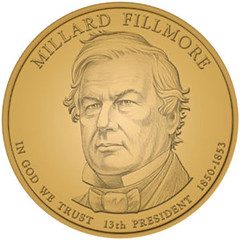 On February 18th 2010 United States Mint Assistant Director Andy Brunhart and the citizens of Moravia, NY, and environs, descended on the tiny hamlet of four thousand to honor our 13th President with the newest United States one dollar coin. Moravia is the closest town to Fillmore's birthplace with a high school cafeteria able to hold the event.
On February 18th 2010 United States Mint Assistant Director Andy Brunhart and the citizens of Moravia, NY, and environs, descended on the tiny hamlet of four thousand to honor our 13th President with the newest United States one dollar coin. Moravia is the closest town to Fillmore's birthplace with a high school cafeteria able to hold the event.
Fillmore was born in nearby Locke, NY (which is now known as Summerhill) on the 7th day of February in the year of our lord 1800. I took the trip down to Moravia from Rochester, along with a few members of the Rochester Numismatic Association. The drive is about two hours in length on rambling country roads and county byways. The scenery is breathtaking and one would think they were in rural Vermont or Pennsylvania rather than in the New York of skyscrapers and tarmac.
I arrived in town at 9:35 AM having just driven the 100 miles alone and at peace, but now to my surprise there was a long line of cars moving slowly to the entrance of the High School. I was motioned by a policeman to turn left into the lot and had to search around to find a place to park.
It was a good thing I arrived at the precise time I did because there was a long line of people waiting to get in, I just barely did before they closed off the cafeteria and placed speakers out in the corridor.
Master of Ceremonies John Haight discussed Robert J. Scarry, a local history teacher and Millard Fillmore crusader. It was an interesting talk but at times I wondered if the ceremony was to deliver the Millard Fillmore Dollar or to honor Robert Scarry.
In short order United States Mint Director Andy Brunhart was introduced and he, thankfully stepped to the podium and said, "it seems most of my speech has been delivered previously and so I promise you we will be done when the second hand of that clock (points to the cafeteria clock in the back wall) reaches 15 after." I looked and as one the whole crowd craned their necks saw it was mere ten minutes away and a collective groan was stifled.
Asst. Director Brunhart discussed the United States Mint, the new dollars, threw a platitude Fillmore's way and then introduced two young children, to the podium where he said, "Now the moment we have been waiting for, the official dollar pour." Brunhart and the two children picked up a wash bucket sized barrel and poured out approximately 250 shiny new Millard Fillmore dollars and said, "we hereby dedicate the Millard Fillmore dollar." and the ceremony was over.
I want to thank Genevieve Billia and also the United States Mint as this was more than I could have hoped for, our American history is a great one; and coin collecting is a microcosm of that history. It leads into the nooks and crannies of our societies past and if you take the time to look further than the price list you will find stories to enlighten and enjoy.
Assistant Director Brunhart was considerate, accessible, and a gentleman. Refreshing in this day of hurried bureaucrats who are more scared of the public they serve, and more worried about keeping their job, instead of doing that job. The United States Mint team looked like they were really enjoying themselves and the folks of Moravia. The ceremony was a small town, one Post Office affair, a town filled with very nice folks, where likely the Postmaster knows just about everyone.
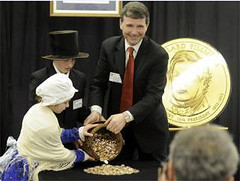 With close to 1,000 witnesses watching, a young Millard Fillmore impersonator and his equally sprite make-believe wife Abigail poured from a wooden bucket a stream of coins bearing the face of the 13th president and Moravia native.
With close to 1,000 witnesses watching, a young Millard Fillmore impersonator and his equally sprite make-believe wife Abigail poured from a wooden bucket a stream of coins bearing the face of the 13th president and Moravia native.
The United States Mint Thursday released its 13th presidential dollar coin, honoring Millard Fillmore, at a ceremony in the Moravia Junior Senior School cafeteria, which was not large enough to accommodate the crowd of community members who had come to celebrate a president whose national legacy is not legendary, but whose roots are their roots.
"This is a grand, grand event," Moravia Mayor Gary Mulvaney said, as he waited in a line that started at the cafeteria doors and wound through the school.
A separate coin release was held in Buffalo, where Fillmore is buried. As outlined by the Wall Street Journal Thursday, Buffalo wanted to host the official U.S. Mint event, but was passed over for the site of Fillmore's beginning.
The U.S. Mint holds its presidential coin release events at a place of historic significance to each president for exactly that reason demonstrated by the hundreds of people who came to see Fillmore's coin - the connection a group of people feel to those who lived there before them, said Andrew D. Brunhart, deputy director of the U.S. Mint.
"When we come to a person's home state and remember and recognize their history it rejuvenates and refreshes all of us on their contributions to our nation," said Brunhart.
Brunhart said he has seen crowds as large as 5,000 and as small as 70. Thursday's turnout was evidence that Fillmore is an important part of the area's culture that residents greatly value.
After the ceremony concluded, the crowd shifted to tables where children could claim their own Fillmore coin for free and adults could purchase them, which they did, leaving with multiple $10 rolls.
To read the complete article, see: Moravia celebrates Fillmore coin release (www.auburnpub.com/articles/2010/02/19/local_news/news01.txt)
1868 THREE-CENT NICKEL FOUND IN CHANGE AT CHIC-FIL-A
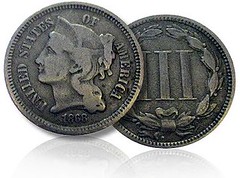 Recently ... I was notified of a in-circulation find that I'm fairly certain even I would have noticed. In an email from my brother in the Richmond, Virginia, area, he noted that a co-worker had discovered an unusual coin in his pocket change. A U.S. coin, but one that didn't quite look right. I contacted the finder, and he provided me with this narrative (slightly edited for publication):
Recently ... I was notified of a in-circulation find that I'm fairly certain even I would have noticed. In an email from my brother in the Richmond, Virginia, area, he noted that a co-worker had discovered an unusual coin in his pocket change. A U.S. coin, but one that didn't quite look right. I contacted the finder, and he provided me with this narrative (slightly edited for publication):
"I went through the drive-through at the local Chic-fil-A to get a milkshake. I confess to a serious addiction to their milkshakes. I got the change and stuffed it my pocket and drove off for home.
When I was getting ready to throw the change into the coin jar on the kitchen counter, I noticed that a couple of quarters looked very new. My wife is saving state quarters to make full sets for the grandkids and I'm under instructions to check any good ones to see if she needs them.
The quarters were of no interest, but I noticed a dime that had a strange kind of patina to it and took a closer look. Frankly, my first thought was that I had probably gotten a Canadian coin.
I didn't know what it was, so off I went to the web, where I found out it was a three-cent coin (thus, the Roman numeral III), a little about its history, and a few prices. That's about it.
I'd hate to think it was some other guy like me who just thought it was a dime and had no idea what he'd just spent for a sugar and chocolate fix.
As for coin collecting, I now have a one-coin collection."
He sent a couple of snapshots of this well-worn coin to my brother, who forwarded them to me.
Wondering how this nearly 150-year old coin, minted in the fourth year of a denomination last produced in 1889, found it's way into a Chick-fil-A cash drawer leads to interesting speculation.
We will probably never know why this coin ended up at a Chick-fil-A, but it seems likely it passed through a couple of hands, and possibly a bank or two, on its way to a new home as the star coin of a one- coin collection.
Perhaps the most intriguing question is wondering whether there were others like this from the original source, also placed into circulation and now waiting to be found. And as unlikely as this last possibility might be and though I live a long way from Virginia, I think I'll be looking a little more closely at my pocket change from now on
To read the complete article, see: Pocket Change Yields an Unusual Find (www.coinlink.com/News/us-coins/pocket-change-yields-an-unusual-find/)
WAYNE'S NUMISMATIC DIARY: MARCH 9, 2010
I didn't get a chance to write about last month's meeting of my Northern Virginia numismatic social group, Nummis Nova, but we had a good time at Café Oggi. Dick Doty of the National Numismatic Collection at the Smithsonian was able to attend, and it was great to see him.
The host for our March meeting was Tom Kays. He picked Mango Mike's in Alexandria, a fun Caribbean-themed restaurant with a great bar, tiki torches and huge tropical fish tanks. Our table was right in front of one of the tanks, providing a soothing backdrop for our conversation.
Dick couldn't make it this month, but Dave Schenkman brought a guest - Gene Brandenburg, who owned the Old Town Coin & Jewelry shop in Alexandria. It was nice to meet him, although I was seated at the far end of the table most of the evening. I asked Tom Kays for a report on the topics up at his end. He writes:
Apparently I sat at the deep end of the table, numismatically speaking. Gene Brandenburg, who some of us have known for many years came at Dave's invitation. Passed around were plantains with black bean hummus appetizers along with some advanced show-and-tell coins sporting multiple dates.
Some of the coins were in flips written by Elvira Clain-Stefanelli, including
- a wonderful triple dated, 1692 Louis XIV Quart d' Ecu aux huit "Ls" of Perpignan where the undercoin design is clearly dated 1650 (still Louis XIV but depicted as a youngster beneath an older portrait - shades of the picture of Dorian Gray),
- a flip-over double struck Canadian provincial colonial copper of 1812,
- a beautifully double struck and double dated 1775 contemporary counterfeit English copper half pence of suspected American origins,
- an ancient silver stater of Corinth (undated) with Pegasus in accord with our March theme of "ancients - anything goes".
- An interesting 1709 medal by Caspar Gottlieb Lauffer and engraved by Martin Brunner of Nurnberg in white metal, reminiscent of the early Betts medals was passed around that even Joe Levine had not seen before, commemorating the capture of Tournai during the War of Spanish Succession (Forster 754, Elmer 436) with a quote from Vigil in raised lettering around the edge.
Gene talked about surprises heirs find in safe deposit boxes (such as purloined DuPont coins) and other issues arising when trustees demand a coin inventory. We talked about the next Coins4Kids event at the Annandale Show. Even our waitress wanted to talk coins regarding her friend's collection carried out of the old country by white Russians who crossed over from Europe by way of Germany long ago. It was a great night at Mango Mikes, being low priced lobster night to boot.
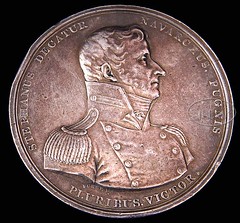 Back at my end of the table I spoke with Joe Levine, Chris Neuzil and Bill Eckberg. There was some talk about Gene's store, and two medals recently sold in a James D. Julia auction, both examples of the rare 1812 Stephen Decatur medal. Both had come to the auction via different branches of the Decatur family. One sold for $28,750, the other for $19,550.
Back at my end of the table I spoke with Joe Levine, Chris Neuzil and Bill Eckberg. There was some talk about Gene's store, and two medals recently sold in a James D. Julia auction, both examples of the rare 1812 Stephen Decatur medal. Both had come to the auction via different branches of the Decatur family. One sold for $28,750, the other for $19,550.
Bill passed around a photocopy of the Chief Coiner's book from the U.S. Mint archives. He's giving a talk at this summer's American Numismatic Association convention in Boston and wanted our thoughts on a perplexing entry. The book lists the names of two "Coiners". These are the folks who actually operated the coin press. But Bill wondered why there were only two names listed - the technology of the day (1793) required THREE people to operate the press - two to swing the arm, and a third to place blanks and retrieve struck coins. We speculated, but didn't come to a conclusion.
I rarely come to a meeting without coin books. Before our dinners came I passed around my copy of A Griffin in Her Desk, the first book in the "Mrs. Moneta" children's series that I reviewed in last week's E-Sylum. I also passed around my copy of Bob Leonard's Curious Currency. In line with the restaurant's theme, Tom Kays passed around a book on Coinages of Latin America and the Caribbean, gleanings from The Numisamtist published by Quarterman Publications in 1974.
Speaking of "Curious Currency", Jon Radel bought a number of neat items himself, including at least one purchased from dealer Scott Semans - Lanchong Tiger Tongue, a forgery of Lannatai C'ieng Money. Tom Kays passed around three display boxes featuring animals on coins, such as eagles on both ancient and U.S. coins, and an owl on an Athenian coin. Can anyone name ANOTHER coin with an owl on it? I asked Tom for more details, and he writes:
What was in the boxes? I had a case that could be subtitled "echoes of animal iconography" showing eagles, elephants, horses, pigs and lions on ancient coins matched with modern coins that echo the same design and pose.
Some matches in the menagerie included the horse head/neck, looking right with palm tree on a Siculo-Punic, 3rd century BC bronze of Tanit, echoed by the 1787 New Jersey copper, the wet looking, eagle perched left on a Phoenician shekel of Tyre (actually perched on the prow of a boat) echoed by the 1907 U.S. Indian ten dollar gold piece with bald eagle in similar feathery pose, or the Roman elephant with trunk raised, right, on a Denarius of Julius Caesar from 44 B.C., echoed by the Republican elephant on a Landon-Knox "Sunflower" presidential campaign pin of 1936.
As a side topic I met a fellow at the well attended Alexandria Coin Show who asserts he can find no books that were printed in New Amsterdam, (Dutch) New York. The question posed is whether none were printed, or did none survive? Dutch printing press technology was later discouraged from export to the English, circa 1680, but does any E-Sylum reader know of any book published in New Amsterdam?
Tom can always be counted on for some impressive exhibits, and the night was no exception. I really need to remember to bring both a flashlight and magnifier to the meetings.
Since the theme was Ancients, I brought along a cute little item from my library: James Ross Snowden's The Coins of the Bible and Its Money Terms, Philadelphia, 1864, 94pp. U.S. Mint Director Snowden collected and published several short papers he'd written for a "Sabbath-school paper". My copy is actually a second edition from 1866. It's only 6 inches tall and four inches wide. Do any of our readers have a copy of this?
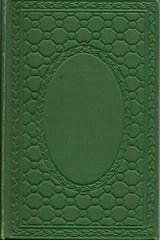

Tom Kays handed me a bag containing a generous donation of coins to give away at upcoming Coins4Kids events. When I visited the other end of the table, Gene mentioned he could donate as well. He asked, "How big's your car?" Looks like we found the mother lode of donations.
Before leaving I spoke with Jon Radel and Wayne Herndon, and we made plans for the next kids' event at the Dulles Coin show on April 24th. It was another great evening of numismatic fellowship. I told Gene how I'd modeled the group after The Sphinx Society in Pittsburgh. The group has no officers, no reading of the minutes, no chores - just relaxing conversation about numismatics and any other topic that happens to come up. He enjoyed himself and I think we'll be seeing him at future events. We're already looking forward to next month.
THE BOOK BAZARRE
THE PICTUREIT RARE BOOK READER
Modeled on similar projects at The British Library and the National Library of Medicine, our "PictureIt" site puts some of the most beautiful and soughtâafter items in our collections into the hands of readers worldwide - virtually.
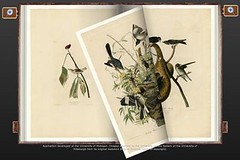 The first of our treasures accessible in this way is volume one of John James Audubon's Birds of America. Our
eightâvolume, doubleâelephant folio edition of Audubon's magnificent work was the first purchase by the Regents for the University Library. The Regents paid $970 - an extraordinary expenditure in 1838 - for the set, a
significant act of faith for a university that had yet to offer a single class or construct its first building.
The first of our treasures accessible in this way is volume one of John James Audubon's Birds of America. Our
eightâvolume, doubleâelephant folio edition of Audubon's magnificent work was the first purchase by the Regents for the University Library. The Regents paid $970 - an extraordinary expenditure in 1838 - for the set, a
significant act of faith for a university that had yet to offer a single class or construct its first building.
I have mixed feelings about it. It's nice to let more people have access to a rare book. (In this case, there are only about 120 sets extant). But it's nothing like seeing the book. In fact, I find Pittsburgh's own presentation of the same images to be more useful.
And neither compare to the weekly visits I made to the Amherst College Library's Special Collections to see the next page. Of course, even over 4 years I didn't get a chance to see all 435 plates. Eight years of grad school should been enough to see the remainder but I don't think I knew that Michigan also owned a set and they didn't have it on view back then.
To read Birds of America with PictureIt, see: PictureIt Rare Book Reader (www.lib.umich.edu/news/pictureit-rare-book-reader)
To see the University of Pittsburgh presentation, see: Audubon's Birds of America (digital.library.pitt.edu/a/audubon/)
COLLECTING E-BOOKS?
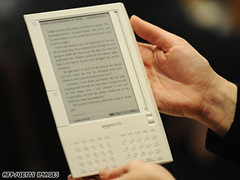 People who reject e-books often say they can't live without the heft, the texture and â curiously â the scent of traditional books.
People who reject e-books often say they can't live without the heft, the texture and â curiously â the scent of traditional books.
No less a reader than the cultural critic Walter Benjamin, as card-carrying a man of letters as the world has ever seen, savored the physicality of books. In his 1931 essay "Unpacking My Library: A Talk About Book Collecting" â Benjamin turns euphoric while surveying his dusty books. He's enchanted by each one: "the period, the region, the craftsmanship, the former ownership." In acquiring books, often in mock-heroic ways, he says he has managed "to renew the Old World."
So how do I display or otherwise admire all these books I keep buying for the Kindle?
Unpacking my Kindle library, I click "menu" on my screen and find . . . a list.
Beholding "the several thousand volumes that are piled up around me," Benjamin exclaims: "O bliss of the collector! Bliss of the man of leisure!" With nothing piled up around me but the Kindle and its charger, I may be missing out.
But even Benjamin, who managed to see the future of media and technology more than once, knew he was writing an elegy for a way of experiencing books. I like to think he would be the first to recognize that the Kindle delivers a new kind of bliss.
To read the complete article, see: Collecting E-books? (www.nytimes.com/2010/03/07/magazine/07FOB-medium-t.html)
OLD BANK OF ENGLAND 20 POUND NOTE BEING DEMONETIZED
Have a look in your wallet: any £20 notes with the image of Edward Elgar on them will not be legal tender after June 30 this year.
This means that shops no longer have to accept the notes, and it is up to banks whether they agree to swap notes after this date.
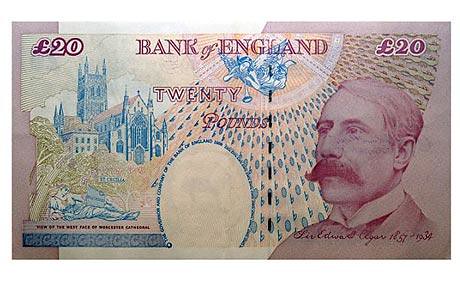
From July 1 only notes with the image of Adam Smith, the Scottish economist, will be legal tender. These notes came into circulation in March 2007.
About 10 per cent of all £20 notes in circulation - equating to 150 million notes, worth £3 billion - are the old versions featuring the English composer. They were introduced in June 1999 along with a view of the west face of Worcester Cathedral, replacing the previous series of notes featuring Michael Faraday, the physicist, and before that William Shakespeare.
The Adam Smith design was introduced to cut down on forgeries. The new £20 design included more of the printed words raised and a greater number of flecks that show bright red and green under an ultraviolet light.
Old notes will eventually be sent to one of the official Government incinerators, where they will burned alongside damaged notes. A small amount of thermoelectric power is generated by these sites, which also burn illegal tobacco seized by HM Revenue & Customs at British ports.
After June 30 if a bank or building society refuses to swap a note, consumers have the right to swap the notes at the Bank of England itself. The Bank promises that it will honour the face value of any note issued, even notes from before the Second World War.
To read the complete article, see:
Elgar £20 note no longer legal tender
(www.telegraph.co.uk/finance/personalfinance/consumertips
/banking/7397202/Elgar-20-note-no-longer-legal-tender.html)
MAN CAUGHT SUCKING COINS TO BEAT BREATHALYSER TEST
WELSH rugby legend JPR Williams sucked pennies in a police car in an attempt to cheat a drink-driver charge, a court heard today.
Former British Lions and Wales star JPR - a qualified surgeon - popped three pennies into his mouth when he was in the back of a patrol car.
The court heard he believed a "myth" that the copper in the pennies would lower the alcohol reading in a breathalyser test.
But police told him to stop sucking the coins - and he was yesterday banned from driving for 17 months.
Prosecutor Hannah Norton said: "While in the police car, Mr Williams had to be instructed twice to remove items from his mouth, those being three one penny coins.
Prosecutor Hannah Norton said: "While in the police car, Mr Williams had to be instructed twice to remove items from his mouth, those being three one penny coins.
"There is a myth that the copper from these coins can interfere with the breathalyser machine."
After the case, a spokesman for breath test makers AlcoDigital said: "This is a complete myth that sucking coins can affect a reading. These machines are pretty much fool-proof - sucking a copper coin will make no difference."
To read the complete article, see:
Wales rugby legend JPR Williams sucked coins to try to beat alcohol breath test
(www.thisissouthwales.co.uk/southwalesnews/Wales-rugby-legend
-JPR-Williams-sucked-coins-try-beat-alcohol-breath-test/article-
1892240-detail/article.html)
THE "GELT SUIT"
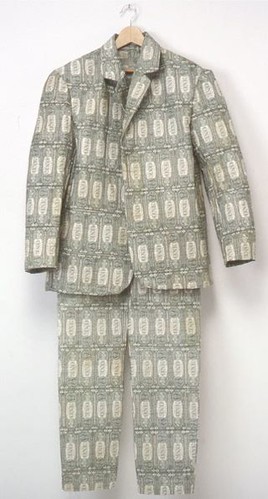 Dan Freidus submitted this interesting piece of art fashion. He writes:
Dan Freidus submitted this interesting piece of art fashion. He writes:
The "Gelt Suit" is apparently referencing a work by Joseph Beuys (called "Felt Suit"). Beuys is probably best known for his 1974 performance piece "I like America and America likes me" in which he spent three days locked in a room with a coyote.
To read the complete article, see:
Exhibitions Katonah. Dress Codes: Clothing as Metaphor. The Katonah Museum of Art. The Curated Object
(www.curatedobject.us/the_curated_object_/2009/07/exhibitions-katonah-.html)
FEATURED WEB PAGE: THE SYDNEY COVE MEDALLION
This week's Featured Web page is about an exhibit at the National Museum of Australia in Canberra, which features a 1789 medal by Josiah Wedgewood.
Josiah Wedgwood made this medallion in 1789 to commemorate the landing of the First Fleet. It is made of clay collected at Sydney Cove by Governor Phillip. He sent the sample to Sir Joseph Banks, who sent it on to Wedgwood to test its suitability for making china.
Wedgwood made the sample into a commemorative medal titled, 'Hope encouraging Art and Labour, under the influence of Peace, to pursue the employments necessary to give security and happiness to an infant settlement'.
It is more commonly known as the Sydney Cove medallion.


www.nma.gov.au/exhibitions/landmarks/
colonial_foundations/
